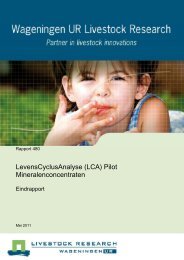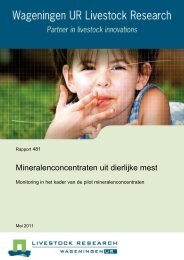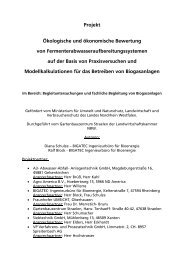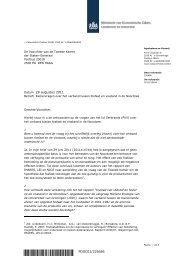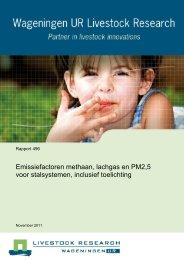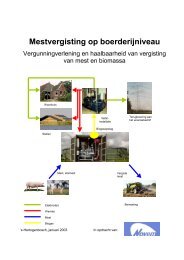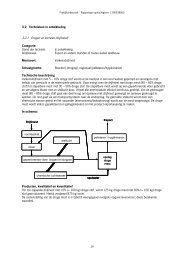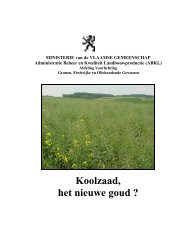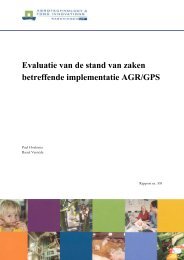Monitoring methane and nitrous oxide reduction by manure treatment
Monitoring methane and nitrous oxide reduction by manure treatment
Monitoring methane and nitrous oxide reduction by manure treatment
You also want an ePaper? Increase the reach of your titles
YUMPU automatically turns print PDFs into web optimized ePapers that Google loves.
Report 627<br />
Application<br />
The results found in the literature about the effect of anaerobic digestion on the emission of NH3 after<br />
+<br />
<strong>manure</strong> application are not consistent. Due to the higher pH <strong>and</strong> NH4 -N in digested <strong>manure</strong><br />
compared to untreated <strong>manure</strong>, higher NH3 emissions are expected after <strong>manure</strong> spreading. However,<br />
the lower dry matter content (better infiltration into the soil) of digested <strong>manure</strong> would suggest just the<br />
contrary, lower NH3 emissions from digested <strong>manure</strong> after spreading. Mosquera & Hol (2007) found in<br />
two of three field experiments higher NH3 emissions after (narrow b<strong>and</strong>) application of digested<br />
<strong>manure</strong> (compared to untreated <strong>manure</strong>) to grassl<strong>and</strong>. The other experiment resulted in lower NH3<br />
emissions. Sommer et al. (2006) reported significant higher NH3 emissions after (broadcast)<br />
application of co-digested <strong>manure</strong> compared to untreated <strong>manure</strong>. This was explained <strong>by</strong> the higher<br />
pH of digested <strong>manure</strong>. Amon et al. (2006) also found significant higher NH3 emissions after the<br />
application of digested cattle <strong>manure</strong> compared to untreated cattle <strong>manure</strong>. Wulf et al. (2002a) also<br />
came to similar results <strong>by</strong> (narrow b<strong>and</strong>) application of digested <strong>and</strong> untreated cattle <strong>manure</strong> on both<br />
grassl<strong>and</strong> <strong>and</strong> arable l<strong>and</strong>. The emissions were not significantly different. Rubaek et al. (1996) found<br />
no significant differences in NH3 emission between co-digested <strong>manure</strong> (20% rest products with pig<br />
<strong>and</strong> cattle <strong>manure</strong>) compared to untreated <strong>manure</strong> <strong>by</strong> <strong>manure</strong> injection. (Narrow b<strong>and</strong>) application of<br />
digested <strong>manure</strong> resulted in similar to lower NH3 emissions compared to untreated <strong>manure</strong>. Clemens<br />
et al. (2006) found higher NH3 emissions after (narrow b<strong>and</strong>) application of digested cattle <strong>manure</strong> on<br />
grassl<strong>and</strong> compared to untreated <strong>manure</strong>, although the differences were not significant. Pain et al.<br />
(1990a) found higher NH3 emissions after (broadcast) application of digested pig <strong>manure</strong> on grassl<strong>and</strong><br />
compared to untreated <strong>manure</strong>. The differences were in this study also not significant.<br />
Anaerobic digestion removes organic matter <strong>and</strong> affects infiltration of <strong>manure</strong> slurry <strong>and</strong> the content of<br />
volatile solids in the soil-slurry mixture. Reducing VS in the soil-slurry mixture reduces risk of N2O<br />
emissions, as the lower VS content decreases microbial dem<strong>and</strong> for O2 <strong>and</strong> consequently<br />
denitrification. Some researchers have reported lower N2O emissions from soils amended with<br />
digested slurries than from untreated slurries (Petersen, 1999; Bh<strong>and</strong>ral et al., 2009), but this<br />
response has not been consistent (Amon et al., 2006; Clemens et al., 2006; Thomsen et al., 2010),<br />
suggesting that application conditions <strong>and</strong> soil properties may influence effects of digested slurries on<br />
N2O emissions.<br />
Clemens & Huschka (2001) <strong>and</strong> Amon et al. (2006) found lower N2O emissions after the application of<br />
digested cattle <strong>manure</strong> compared to untreated <strong>manure</strong>. Wulf et al. (2002b) found higher N2O<br />
emissions after the application of digested <strong>manure</strong> on grassl<strong>and</strong> compared to untreated <strong>manure</strong>,<br />
although the differences were not significant. On arable l<strong>and</strong>, no significant differences between<br />
digested <strong>and</strong> untreated <strong>manure</strong> were found. Clemens et al. (2006) found also no significant<br />
differences in N2O emission between digested <strong>and</strong> untreated <strong>manure</strong> after (narrow b<strong>and</strong>) application<br />
on grassl<strong>and</strong>.<br />
Wulf et al. (2002b) found, both on grassl<strong>and</strong> an on arable l<strong>and</strong>, lower CH4 emissions after (narrow<br />
b<strong>and</strong>) application of digested cattle <strong>manure</strong> compared to untreated <strong>manure</strong>. Amon et al. (2006)<br />
reported higher CH4 emissions after application of digested cattle <strong>manure</strong> on grassl<strong>and</strong> compared to<br />
untreated <strong>manure</strong>. Clemens et al. (2006) found no significant differences in CH4 emission after<br />
(narrow b<strong>and</strong>) application of digested cattle <strong>manure</strong> on grassl<strong>and</strong> compared to untreated <strong>manure</strong>.<br />
Pain et al. (1990a) measured a <strong>reduction</strong> of 70-80% in odour emissions during the first 6 hours after<br />
application of digested pig <strong>manure</strong> compared to untreated <strong>manure</strong>. Hansen et al. (2006) found lower<br />
concentrations from the emitting surface (17% <strong>reduction</strong>) after application of digested pig <strong>manure</strong><br />
compared to untreated <strong>manure</strong>. Harreveld (1981) also reported lower odour concentrations for<br />
digested <strong>manure</strong>. The explanation for this <strong>reduction</strong> in odour concentration <strong>and</strong> emission is that easy<br />
degradable organic matter in digested <strong>manure</strong> is lower than in untreated <strong>manure</strong>. Besides, <strong>manure</strong><br />
can easily infiltrate into the soil (lower dry matter content).<br />
16





